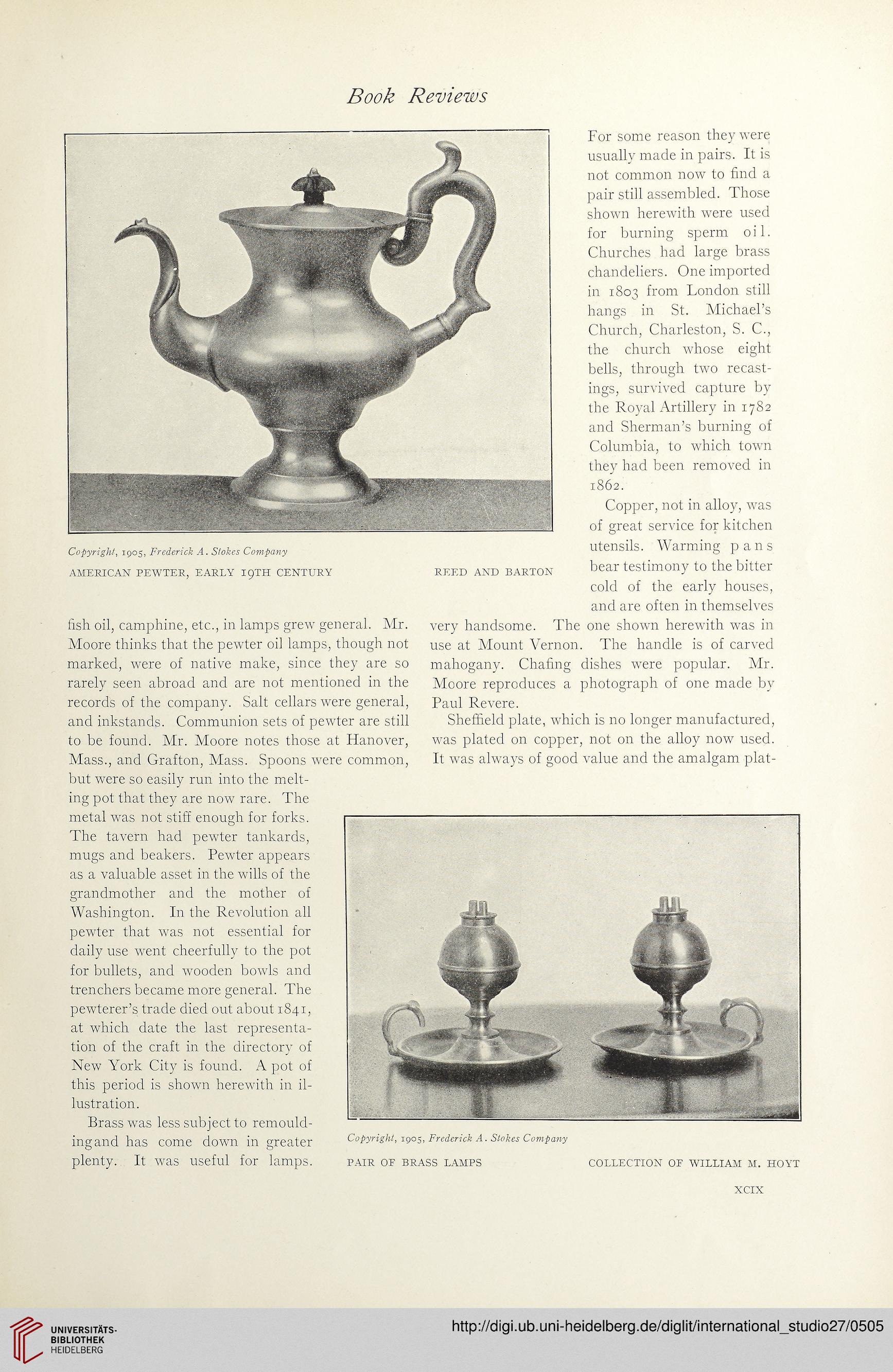Book Reviews
Copyright, 1905, Frederick A. Stokes Company
AMERICAN PEWTER, EARLY I9TH CENTURY
fish oil, camphine, etc., in lamps grew general. Mr.
Moore thinks that the pewter oil lamps, though not
marked, were of native make, since they are so
rarely seen abroad and are not mentioned in the
records of the Company. Salt cellars were general,
and inkstands. Communion sets of pewter are still
to be found. Mr. Moore notes those at Hanover,
Mass., and Grafton, Mass. Spoons were common,
but were so easily run into the melt-
ing pot that they are now rare. The
metal was not stiff enough for forks.
The tavern had pewter tankards,
mugs and beakers. Pewter appears
as a valuable asset in the wills of the
grandmother and the mother of
Washington. In the Revolution all
pewter that was not essential for
daily use went cheerfully to the pot
for bullets, and wooden bowls and
trenchers became more general. The
pewterer’s trade died out about 1841,
at which date the last representa-
tion of the craft in the directory of
New York City is found. A pot of
this period is shown herewith in il-
lustration.
Brass was less subject to remould-
ingand has come down in greater
plenty. It was useful for lamps.
For some reason they were
usually made in pairs. It is
not common now to find a
pair still assembled. Those
shown herewith were used
for burning sperm oil.
Churches had large brass
chandeliers. One imported
in 1803 from London still
hangs in St. Michael’s
Church, Charleston, S. C.,
the church whose eight
bells, through two recast-
ings, survived capture by
the Royal Artillery in 1782
and Sherman’s burning of
Columbia, to which town
they had been removed in
1862.
Copper, not in alloy, was
of great Service for kitchen
Utensils. Warm in g pans
bear testimony to the bitter
cold of the early houses,
and are often in themselves
very handsome. The one shown herewith was in
use at Mount Vernon. The handle is of carved
mahogany. Chafing dishes were populär. Air.
Moore reproduces a photograph of one made by
Paul Revere.
Shefheld plate, which is 110 longer manufactured,
was plated on copper, not on the alloy now used.
It was always of good value and the amalgam plat-
REED AND BARTON
Copyright, 1905, Frederick A. Stokes Company
PAIR OE BRASS LAMPS
COLLECTION OE WILLIAM M. HOYT
XCIX
Copyright, 1905, Frederick A. Stokes Company
AMERICAN PEWTER, EARLY I9TH CENTURY
fish oil, camphine, etc., in lamps grew general. Mr.
Moore thinks that the pewter oil lamps, though not
marked, were of native make, since they are so
rarely seen abroad and are not mentioned in the
records of the Company. Salt cellars were general,
and inkstands. Communion sets of pewter are still
to be found. Mr. Moore notes those at Hanover,
Mass., and Grafton, Mass. Spoons were common,
but were so easily run into the melt-
ing pot that they are now rare. The
metal was not stiff enough for forks.
The tavern had pewter tankards,
mugs and beakers. Pewter appears
as a valuable asset in the wills of the
grandmother and the mother of
Washington. In the Revolution all
pewter that was not essential for
daily use went cheerfully to the pot
for bullets, and wooden bowls and
trenchers became more general. The
pewterer’s trade died out about 1841,
at which date the last representa-
tion of the craft in the directory of
New York City is found. A pot of
this period is shown herewith in il-
lustration.
Brass was less subject to remould-
ingand has come down in greater
plenty. It was useful for lamps.
For some reason they were
usually made in pairs. It is
not common now to find a
pair still assembled. Those
shown herewith were used
for burning sperm oil.
Churches had large brass
chandeliers. One imported
in 1803 from London still
hangs in St. Michael’s
Church, Charleston, S. C.,
the church whose eight
bells, through two recast-
ings, survived capture by
the Royal Artillery in 1782
and Sherman’s burning of
Columbia, to which town
they had been removed in
1862.
Copper, not in alloy, was
of great Service for kitchen
Utensils. Warm in g pans
bear testimony to the bitter
cold of the early houses,
and are often in themselves
very handsome. The one shown herewith was in
use at Mount Vernon. The handle is of carved
mahogany. Chafing dishes were populär. Air.
Moore reproduces a photograph of one made by
Paul Revere.
Shefheld plate, which is 110 longer manufactured,
was plated on copper, not on the alloy now used.
It was always of good value and the amalgam plat-
REED AND BARTON
Copyright, 1905, Frederick A. Stokes Company
PAIR OE BRASS LAMPS
COLLECTION OE WILLIAM M. HOYT
XCIX





